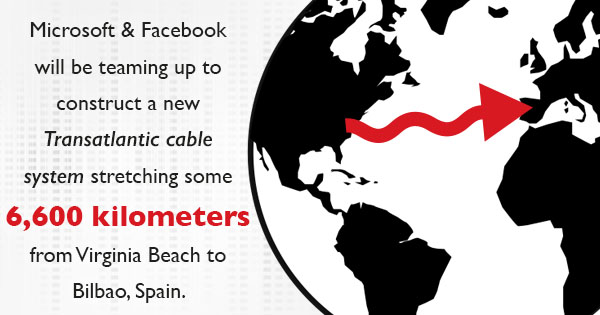
Microsoft and Facebook will be teaming up to construct a new Transatlantic cable system stretching some 6,600 kilometers from Virginia Beach to Bilbao, Spain, according to WIRED.
The fiber optic cables will help speed the transfer of data from the U.S. to other parts of the world. There are already current undersea cables in existence from the likes of Google and other telecommunications industries. However, Facebook and Microsoft are purposely looking to streamline the transfer of large amounts of data directly from their operations in northern Virginia and North Carolina, rather than having to go through hubs in New York City first. The other end location in Spain will also help facilitate the spread of information to Africa, the Middle East, Asia, and the rest of Europe.
“If you look at the cable systems across the Atlantic, a majority land in the Northeast somewhere,” explained Najam Ahmad, Facebook’s Vice President of Network Engineering. “This gives us so many more options.”
The proposed fiber optic cables promise up to 160 terabits per second of bandwidth. That’s 16 million times more than the average home connection, which usually only gets measured in megabits. Every terabit, by contrast, is equal to 1 trillion bytes.
For home and office connections, the length of a cable doesn’t usually have any bearing on video or audio quality. Although, if you’re looking to stretch high-speed HDMI cables over great lengths, it’s usually recommended you invest in a 100ft HDMI cable equipped for the job.
Transatlantic data communication is something entirely different, though. Microsoft and Facebook are reportedly working with “dark fiber,” that is, unused terrestrial cables, to retain better control over data transfers.
“We’re starting to see more of the large Internet content providers looking to build more of their own networks — whether they are leasing dark fiber or laying down new cables to build new routes,” said Michael Murphy, president and CEO of telecom consultant firm NEF. “It makes sense.”
Fiber optic cables have been traversing the Atlantic ocean since the 1850s, though early attempts lasted only a couple of weeks — far less than the five-to-10 year lifespan of even quality cat5 cables today! But current, more-lasting technologies have impacted the way modern Internet companies can conduct their business.
“You’re stuck with whatever system was built initially,” Ahmad said. “And if there has to be an upgrade, all the partners in the consortium have to agree to that upgrade. A new line built just for Facebook and Microsoft “gives us more control of our own destiny,” Ahmad said.



